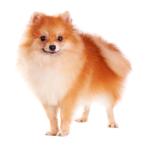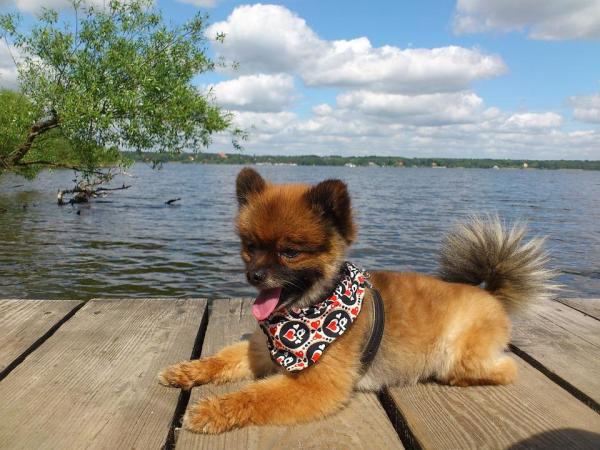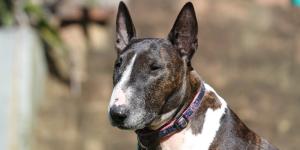Pomeranian Training for Puppy and Adult Dogs



Animal file: Pomeranian
The Pomeranian is a Spitz type dog, beloved around the world for its gentle nature and fluff-ball appearance. Although they also stand out for being relatively docile in character, they require a solid education and the teaching of basic commands to live a full life as a companion animal. This education and training will allow the Pomeranian to live harmoniously with humans, both those in their immediate family and those they come across when outside. There are also certain behavioral problems this breed is prone to developing such as separation anxiety or possessiveness.
In this AnimalWised article, we have compiled a complete guide on Pomeranian training for puppy and adult dogs. In doing so, we reveal some of the character traits and tendencies common to the breed, as well as how you can use this knowledge to develop a happy and healthy canine friend.
- Know your dog before you train them
- Prepare before you start training your Pomeranian
- Your Pomeranian's training needs to be dog specific
- How to train a Pomeranian puppy
- Stages of Pomeranian puppy education
- Training an adult Pomeranian
- How to reassure a Pomeranian
- Socialization is key in educating a Pomeranian
- 5 tips for training Pomeranian dogs
Know your dog before you train them
While we can talk about some guidelines for all Pomeranian dogs as well as look at basic criteria for training all dogs, there is something important to consider. Namely, all dogs are individuals. As you start training your Pomeranian, you will need to work with their personality, so you will need to get to know it. If you are training a puppy, then this character will still be developing and you will need to do all you can do to encourage them in the right way. For adult Pomeranian dogs, their personality will already be established. They ay be more shy or rambunctious, either way you will need to give them patience and love.
We can also look at some general personality traits of the breed to know what we might be able to expect. The Pomeranian is the smallest of the Spitz dog breeds. In dog parks across the world they attract attention for their smooth, silky and voluminous fur which requires specific care and attention to stay beautiful and healthy. Although their ancestors have historically been trained as livestock dogs, this toy-type dog has been bred to be a true lapdog. They are extremely affectionate with their tutors, sometimes quite demanding of attention. When not properly educated, they can become mollycoddled and spoilt.
Fortunately, they are also recognized for their intelligence and ease of learning. They are active dogs which need exercise and intelligence training to keep them physically and mentally stimulated. Doing so establishes a balanced character and reduces behavioral problems.
To get to know you Pomeranian, as with all dogs, you will have to understand their methods of communication. This means reviewing canine body language. This is why we have information on dog positions and their meanings. With a better understand of how canines communicate, you will be better prepared to start educating your Pomeranian.

Prepare before you start training your Pomeranian
Before starting to educate your furry pal, you'll need to be prepared for some of the basic guidelines, methods and fundamentals of dog training. While we will go into some of the specifics here in this Pomeranian training guide, you can take a look at these 5 basic tips on dog training to get started. After introducing yourself to some of the basic dog training concepts, you should also prepare some practical tools to help you along the way. These include:
- Collar/harness
- Normal leash
- Long leash
- Fanny pack
- Treats or snacks
- Games
- Clicker (opcional)
In theory, the clicker is not a mandatory tool for training your Pom. However, its correct use can make the work of a trainer much easier and act as a helpful tool to reinforce good behavior.
Your Pomeranian's training needs to be dog specific
Education, physical stimulation and mental development must be adapted to the individual needs of the dog. This means factoring in their age, health status and mental well-being. For example, you cannot start training an inexperienced Pomeranian puppy with complex tasks and orders. This will only breed confusion, cause frustration and discourage them from continued learning.
K¡Just like children, training a Pomeranian puppy is a progressive task. Assimilation of concepts and orders will occur over time with practice, later to become ingrained pillars of their learned behavior. Little by little your Pomeranian will learn the basic rules and react to canine commands intuitively. After this, you can step up the training if necessary.
During all stages of your Pomeranian's education, you need to utilize positive reinforcement to stimulate their learning. This involves rewarding their efforts and achievements rather than scolding for perceived ‘incorrect’ behavior. Positive education rejects any type of physical or emotional abuse. This includes shouting at or hitting your dog.
Rather than punishing bad behavior, positive reinforcement recognizes and encourages the assimilation of appropriate or desired behavior. In doing so, you can stimulate cognitive, emotional and social skills. It also very positively influences the bond between guardian and dog.

How to train a Pomeranian puppy
The optimal age to begin training your Pomeranian puppy is 3 months. At this time, the puppy should be fully weaned and ready to begin learning simple exercises. When deciding to adopt a Pomeranian puppy, it is very important to certify that the weaning period has been carried out properly. This means the puppy must not be removed from their mother and siblings before a minimum of 2 months, but ideally longer.
When a puppy is removed from the litter, the dog can develop socialization problems and learning difficulties as their source of security is taken away from them. Anxiety and other behavioral issues may develop as a result. Physically, improper weaning can also negatively affect their immune system and make them vulnerable to certain diseases.
However, if your Pomeranian puppy is born in your own home, you can begin education from birth. You will still need to respect their very young age and lack of development, but you can still encourage them. You can't toilet train a Pomeranian puppy when they are newborn or teach them tricks. You can start to teach them to recognize their own name and establish some general rules of the home.
For example, you can ensure they know it is not OK to jump onto beds, gnaw on the couch or eat garbage. This will be a more intuitive training method than when they are older and begin to better recognize commands. The objective is basically to discourage the puppy from these behaviors which you don't want to see when they become an adult dog. Remember, reinforcing bad behavior when they are young will mean this needs to be corrected in adulthood. Prevention is always better than cure.
On the other hand, if you want to investigate how you can develop cognitive ability from an early age, you can take a look at this information on general care for puppies. In regards to physical activity for puppies, it's important to remember that exercises should be low impact and always be entertaining in some way. Play is key in developing physical and mental stimulation for puppies. Being playful awakens their curiosity and heightens their senses.
Crate training Pomeranian puppies
Many people believe that crates (usually actually cages) are a good way to keep Pomeranian puppies out of mischief. They can be left in the cage for hours without worrying about the mess they will cause to the house. The theory is that dogs find this comforting because their ancestors used to be cave dwelling animals. If their ancestors could get used to this, then domesticated dogs must be fine.
Unfortunately, this theory is not only unsubstantiated, but it can be very cruel. Crate training keeps the dog locked up and away from the family they love. It is seen by the dog as punishment and, although you can get crate train a dog, it may lead to serious behavioral disorders. One example is a dog called stretch, who in a 2017 study was found to develop the anxiety related disorder pica likely due to being kept in a cage for 8 hours a day[1]. This is why we aren't even going to discuss any methods on how to crate train a Pomeranian.
Stages of Pomeranian puppy education
To help train a Pomeranian puppy, here we can show you the general stages of their development. These stages are divided from 3 to 12 months of age, after which you can start to learn options for teaching an adult dog.
- 3 to 6 months: we can start teaching puppies basic obedience commands from the age of 3 months. Examples include sitting, standing, lying down, coming when called, walking beside you and not pulling on their leash. In this stage, the objective is to present simple and uniform commands which do not require the execution of multiple tasks to succeed. If we give orders which are exaggerated to too complex, we can confuse the puppy and cause frustration. This will be counterproductive in their learning. At this age, your Pomeranian puppy will also be ready to learn to do their business outside and start their socialization. This means presenting them to environments, animals and people outside of the home. Remember that socialization is key so that your Pomeranian can relate positively to stimuli, individuals and objects in their environment, thus preventing behavioral problems.
- 6 to 12 months: after your Pomeranian puppy has learned basic commands, you can incorporate new orders into their training. In this second main stage, we advise you to start learning fetch and releasing their bite. You can also add tricks and activities that are both enjoyable for you and your furry pal such as ‘giving a paw’. Always remember to respect your Pom's routine and not to push them to do anything which makes them feel uncomfortable or exhausted.

Training an adult Pomeranian
When your Pomeranian has assimilated basic dog training commands, you may be surprised at their intelligence and receptiveness. Now some more advanced training can be engaged. This might include searching activities which are designed to stimulate the senses and intelligence of your dog. In particular, it helps refine their already advanced olfactory ability. Later on you can develop even more tricks and canine skills such as:
- Playing dead
- Bringing particular objects (e.g. remote control)
- Going to specific places
- Jumping on platforms
You can also begin practicing intelligence games at home with your Pomeranian, take them for walks in new environments, travelling together and teaching amusing tricks. This is done by taking advantage of their natural intelligence and the fact they love to spend time with you. All this will serve as compliments to their basic education and training as well as strengthening your bond.
If you don't think you have enough time to sufficiently develop your dog's education or you need some help in developing your own knowledge, it is best to go to a professional dog trainer. They will be able to show you specific training methods and answer any doubts you might have.
How to reassure a Pomeranian
One of the most frequent questions dog trainers get asked during the education process is how to calm an overexcited Pomeranian. These dogs can tend towards excitement, hyperactivity and even anxiety, especially when puppies or young dogs.
First of all, you need to remember how imperative mental and physical stimulation are for your Pomeranian's well-being. If they do not have these things, it is unlikely they will be able to show balanced behavior and be calm. If your Pomeranian does not exercise enough and doesn't have an enriched environment at home, they can show symptoms of stress and develop behavioral issues. These may include destructiveness or even separation anxiety. Environmental enrichment requires having enough objects and activities in their home to ensure they do not get bored.
You should also consider the fact that Pomeranian dogs do not adapt well to being on their own. These dogs are particularly known for the attention they demand from their human guardians. You will need to reserve enough time throughout the day for active engagement with your dog. A Pomeranian which spends many hours alone and does not receive the care they need will act disruptively. This will harm them as well as cause upset in the home.
You also need to be vigilant against reinforcing anxious or hyperactive behavior. Positive reinforcement involves offering them treats or rewards for when they stop. However, you need to ensure you get the timing right. If you give your Pom a treat to stop them barking, you will only reinforce this negative behavior. It is only when they are silent and well-behaved that they should be rewarded. You can do the same when they behave positively such as when they go to rest, are patient for food or acting calm in an otherwise stressful situation. Your prior education giving obedience orders will also help here. You can get them to lie down, sit or follow your commands when they are especially nervous.
While Pomeranian dogs do have a tendency towards anxiety, they should not be overly so. If they are still not calmed by spending time and providing a positive routine, you will need to take them to the veterinarian. Hyperactivity or anxiety can be signs of pathological issues. A veterinary medical professional will be able to provide a sufficient examination or carry out necessary tests. If the Pomeranian is overly anxious, they may even be prescribed medication to deal with them.

Socialization is key in educating a Pomeranian
Socialization is a key aspect in your Pomeranian's well-being. During this process, they will learn how to relate positively to people, with other dogs and even with other animals. They will learn how to share toys and not react negatively to stimuli in their environment. This will allow them to enjoy a healthy social life and reduce fears and phobias related to being with others.
The optimal period to begin socializing your Pomeranian is when they are a puppy, most importantly between the ages of 3 weeks and 3 months of life. During this phase, dogs form their basic understanding of coexistence with other individuals. They will also demonstrate a more flexible nature and should develop sharing behaviors. As disease transmission is always a concern when interacting with other animals, you will need to wait until the first vaccination and deworming schedules are carried out.
If you have adopted an adult Pomeranian, it is important to know it is never too late. It is still possible to carry out the socialization process in adult dogs and encourage healthy behavior.
5 tips for training Pomeranian dogs
Finally, we'd like to end our guide to training Pomeranian dogs by offering some general tips to make the process go smoothly. They will also hopefully help to reinforce the training over a long period of time.
- Constancy is key: training is a gradual process and being consistent is imperative. Each new exercise must be properly absorbed, memorized and execute properly. This requires patience and, even if you are frustrated, you cannot lose your temper. They will need to assimilate commands one by one which can take time. If you do not have the time, patience of resources, you will need to hire a professional to help.
- Know when to stop: training sessions with your dog should be regular, but short. Ideally, you will only want to spend about 10 to 15 minutes a day on training and education. If you do too much, you may overload them and your efforts will be counterproductive. If you do want to do more, you can do a couple of sessions a day at the beginning and end of the day.
- Identify where to teach: the exercises need to be practiced one by one to allow for understanding and execution. Each dog will need to understand and assimilate the information in their own time. How long it takes to learn each task will depend on complexity of the exercise. To avoid confusion, you should choose the most appropriate place to carry it out. Do it somewhere free of excessive noise and distraction, but also somewhere they can associate with learning and not resting, playing, etc.
- Use positive reinforcement: we can't reiterate enough how necessary positive reinforcement is when training your Pomeranian. Remember that exposing your dog to stressful situations or fear-inducing contexts, punishing them unnecessarily or causing emotional pain will harm their health and lead to the development of behavioral problems.
- Review learning: each command and trick will need to be reaffirmed constantly to assure they are remembered. Before every training session where you learn a new task, go over the old ones to ensure they are understood. If they are not, go over these older exercises instead before moving on to something new.

If you want to read similar articles to Pomeranian Training for Puppy and Adult Dogs, we recommend you visit our Basic education category.









